

1283 Logan Avenue
Salt Lake City, UT 84105
lfa_board@yahoogroups.com
Big Cottonwood Canyon was the place and Friday, June 18th, the date. Livingstons were camping overnight at The Spruces Campgrounds. The next day the sun came through tall pines and quakies to warm the campsite.
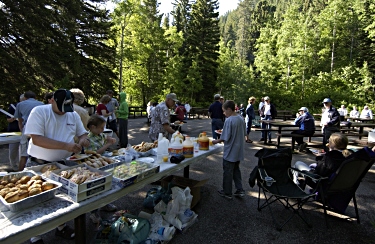 A large cedar fire greeted each family as they arrived. Janet's continental breakfast awaited each group as they arrived, but not before Ross got them registered. Ted was busy practicing his speech for the program and trying to remember the items he wanted to cover in the Board meeting. Enid was making sure the dew was dried from the tables. Shaunna was making sure she had enough prizes for the oldest, youngest, tallest and shortest. Blaine arrived in a beach hat, Charlene in her sunglasses and Dwight was practicing his "resignation from the Board" speech. Everything went as planned, topped off with Janet's buffet lunch, thanks to Stott's excellent planning!
A large cedar fire greeted each family as they arrived. Janet's continental breakfast awaited each group as they arrived, but not before Ross got them registered. Ted was busy practicing his speech for the program and trying to remember the items he wanted to cover in the Board meeting. Enid was making sure the dew was dried from the tables. Shaunna was making sure she had enough prizes for the oldest, youngest, tallest and shortest. Blaine arrived in a beach hat, Charlene in her sunglasses and Dwight was practicing his "resignation from the Board" speech. Everything went as planned, topped off with Janet's buffet lunch, thanks to Stott's excellent planning!
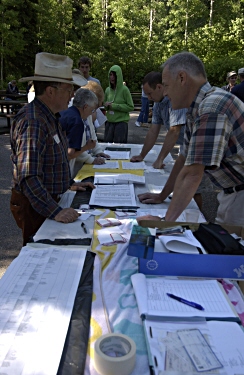
The best was yet to come. We caravanned down Big Cottonwood Canyon and then over to Little Cottonwood Canyon to tour the Temple Quarry. We gathered in an amphitheater in the Quarry to hear a presentation by Ron Watt on the history of the Quarry, the men who labored there, the process of mining the granite and transporting it to Temple Square. Many of our ancestors were part of this process.
It was a day that made you very proud of the great heritage we have as a family. To view more pictures, check out our website at http://livingston_family.org/lfa/reunions/2004. Special Thanks to Dennis Davis for taking all the pictures. They turned out great! Let us know if you know the identity of anyone in the pictures.
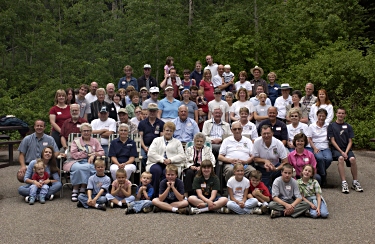
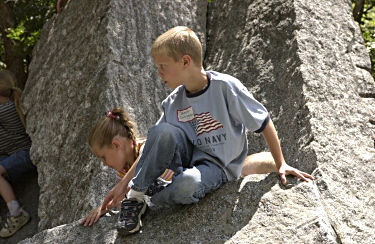
The following is a quote from David Cameron which Ron Watt shared with us at the Quarry. It gives a flavor of what those who worked in the Quarry experienced and felt.
"Well sister, we're not Writers but Workers, learning what it meant to labor for the Lord. When Adam (Adam Hunter) worked there it was difficult to get supplies. The men often went hungry!
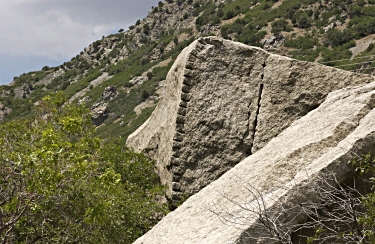 Many times they were sick with mountain fever or rabbit fever. They suffered from snake-bites and bee stings and from mosquitoes and horseflies! Imagine if you can, being blinded by the glistening shafts of sunlight on those white cliffs and deafening by the hell-roaring of all the loosened boulders. And, blistering in the blasts, freezing off fingers and toes! And shuddering during sudden thunderstorms with lightening flashes, being soaked in the rain showers; or pelted with hailstones and later covered with snow! It seems as though we were forever climbing, straining, stumbling, falling, fearing for our very lives! But working on to the dead of winter! Then, going home for Christmas to stay a few weeks, determined to a man to find other employment. We had to please a lot of people besides John Sharp (in charge of the Quarry Mission) and Truman O. Angel (who drafted till his fingers ached on B. Young's Inspired-Temple-Design). Then when we were called into Pres. Young's office to be blessed for our labors, we knew we were not working for Brother Brigham, for anyone else but for the Lord: We labored for His house, not our own; for Him, not for ourselves! We extracted a Granite Temple from the everlasting hills with our bare hands (so to speak) for all the world to see and enjoy for centuries to come and for the benefit of millions for time and all eternity!" (Compiled by Paul A. Hanks, 26 Sept. 1992)
Many times they were sick with mountain fever or rabbit fever. They suffered from snake-bites and bee stings and from mosquitoes and horseflies! Imagine if you can, being blinded by the glistening shafts of sunlight on those white cliffs and deafening by the hell-roaring of all the loosened boulders. And, blistering in the blasts, freezing off fingers and toes! And shuddering during sudden thunderstorms with lightening flashes, being soaked in the rain showers; or pelted with hailstones and later covered with snow! It seems as though we were forever climbing, straining, stumbling, falling, fearing for our very lives! But working on to the dead of winter! Then, going home for Christmas to stay a few weeks, determined to a man to find other employment. We had to please a lot of people besides John Sharp (in charge of the Quarry Mission) and Truman O. Angel (who drafted till his fingers ached on B. Young's Inspired-Temple-Design). Then when we were called into Pres. Young's office to be blessed for our labors, we knew we were not working for Brother Brigham, for anyone else but for the Lord: We labored for His house, not our own; for Him, not for ourselves! We extracted a Granite Temple from the everlasting hills with our bare hands (so to speak) for all the world to see and enjoy for centuries to come and for the benefit of millions for time and all eternity!" (Compiled by Paul A. Hanks, 26 Sept. 1992)
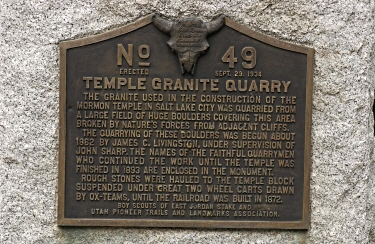

The Livingston Family Reunion is scheduled for the third Friday/Saturday in June -- June 17 & 18, 2005. The Board will be planning the 2005 reunion at our next Board Meeting on October 10 - so, if you have any suggestions, let us know before then. We will send you information on where, what, etc in our January Newsletter. So Mark Your Calendars for next year!
Many thanks to those of you who have contributed to the Livingston Family Association, we appreciate your support. If you haven't made a donation lately, it's not too late. You can still send it to Livingston Family Association, 1283 Logan Avenue, Salt Lake City, UT 84105.
Elections were held during the Business Meeting at the Reunion. The following were elected to the Board: Charlene Clark, Enid Cox, Nadine Curtis. Also, Dwight Epperson resigned his position (he thinks moving to Louisiana is a good reason!) and Ann McDonald was appointed to fill his remaining two years.
Thank you to Shaunna Wozab for many years of dedicated service to the Association. Also thanks to Dwight for his dedicated service - best of luck in your move! We will miss both of these people on the Board, but are looking forward to Nadine and Ann serving on the Board. We are always looking for willing family members to serve on the Board and help on various committees. If you missed the reunion and would like to become more involved, contact us at lfa_board@yahoogroups.com. For your information, the Livingston Family Board members and assignments are as follows:
Livingston Family Board
Term Expires in 2005:
Janet Feeney, Vice Chairman
Ross Livingston, Website
Ted Livingston, Chairman
Term Expires in 2006:
Stott Cook, Reunion Co-Chair
Blaine Livingston, Descendancy Chair
Ann MacDonald, Reunion Co-Chair
Term Expires in 2007:
Charlene Clark, Newsletter & Mailing List
Enid Cox, Secretary/Treasurer
Nadine Curtis, Research Chair
Contact us at 801-484-2678 (Enid's) or email us all at lfa_board@yahoogroups.com
Help us help you find and know your relationships with all our extended family members. Please send a copy of your family groups to the board, so we can build our family tree and make it available to family members at a future date. Include parents and descendants, as applicable, with full names, gender, birth date, and your main Livingston line. Please send this to:
Blaine T Livingston
434 Wheatridge Rd.
Stansbury Park, UT 84074
PAF files can be emailed to lfa_board@yahoogroups.com
Our list of family members receiving the Newsletter via Email is growing. Don't be left out! We would really like to have every family member who has internet access receive the Newsletter electronically - we are calling it ENews. First, it saves the Association on postage and copies (not to mention stapling, folding and stuffing!). Second, and probably more important, the quality of the pictures on the ENews is much better than we can produce in a photocopy. (Check out the Granite Quarry picture on the website - you can actually read James C. Livingston's name!) If you prefer to read a "hard copy" or have one to file away, remember that you can always print ENews from your home computer. Check out past newsletters at http://livingstonfamily.org/lfa/newsletters.html.
If you are willing to give ENews a try, send us your email address today. When it is newsletter time, we will send you an email notifying you that the newsletter has been posted and is ready for reading! We promise not to give away or sell your email address. It will only be used for Livingston Family Association business. Send your email address today to lfa_board@yahoogroups.com. If you are reading this notice via ENews, congratulations and THANK YOU!
The following excerpts of the Salt Lake Temple Quarry were taken from "The Everlasting Spires" by Wallace Alan Raynor. James Campbell Livingston was the general superintendent of the quarry and had complete charge of the work from the time the temple was started until it was finished, Mr, Raynor received a great deal of help and information from Mr. William Kuhre (now deceased) of Sandy, Utah. This material should be of interest to all members of the Livingston Family Organization - for details of his personal life see his autobiography.
On July 28, 1847, four days after the arrival of the Mormon people in the Great Salt Lake Valley, Brigham Young, prophet of their faith and leader of their exodus, accompanied by Heber C. Kimball, Willard Richards, Orson Pratt, Wilford Woodruff, and several others, walked from their north camp to a section of land located between two creeks in the heart of the valley. Brigham Young waved his hand and said, "Here is the forty acres for the Temple. The city can be laid out perfectly square north and south, east and west." It was moved and seconded that the temple lot was to be set aside and to contain forty acres, (Another account claims that Brigham Young struck the ground with the point of his cane and said, "Here we will build the Temple of our God," A Mormon tradition recalls that on this occasion Wilford Woodruff drove a wooden stake into the small hole made by President Young's cane. On Feb. 14, 1853, shortly after the ground was surveyed, it was noticed that the exact center of the plot laid out by the survey for the temple was where Wi1ford Woodruff had placed the stake nearly six years before).
A few days later when the city was being planned and laid out, it was decided that 40 acres was too large and a council was held to determine whether or not to reduce the area to 20 acres, After considerable discussion it was decided that 10 acres would be sufficient. During the ensuing years the people were busy building homes, planting crops and building up the communities as more and more saints arrived. Thus it was not until the April Conference of the Church in 1851, four years after the arrival, that a motion to build the temple was made and carried by acclamation.
During the following year, the people were continually exhorted to pledge their means and efforts toward the project and on Feb. 14, 1853, a large body of Saints assembled on Temple Block for the groundbreaking ceremony. President Young spoke for about 30 minutes after the site was surveyed by Jesse W. Fox, under the supervision of the Church architect, Truman O. Angell. After an interlude of music and song, Heber C. Kimball offered a prayer consecrating the ground. The Presidency then led the procession to the southeast corner of the temple site, where they loosened a piece of earth about 1 foot square. During the groundbreaking ceremony a one dollar silver piece fell on the square foot of earth, and no one knew whence it came, but President Kimball prophesied that it was a good token and means would not be wanted to build the temple. President Young then lifted his spade and cast the first shovel full of earth aside for the building of the temple. He then addressed the multitude and declared the ground broken for the temple, blessed the people in the name of the Lord, and dismissed the assembly. Two months later the corner stones were dedicated by Brigham Young.
A matter of great importance in building the temple was the type of material to be used and its attainability. Thus, the quarries, their tremendous expense, and the enormous amount of skill, labor and time involved in hewing the stones were major factors in the construction of the Salt Lake Temple. Soon after the Mormon's arrival in the valley in 1847 a fine bed of red sandstone was discovered a few miles east of the city in Red Butte Canyon. The rock was easily quarried, being a surface deposit, and was used for buildings extensively in the first few years. The decision on whether this material or some other type was wanted in the Temple was brought before the people in the Oct. 1852 conference of the Church where the subject of temple building was a principle theme.
They talked of using stone from Sanpete, which was a beautiful specimen of rock, or the sandstone that was found in abundance in Red Butte Canyon, or go to Emigration Canyon and get the bastard marble or limestone, or using adobes. Brigham Young said his opinion "was to use adobies, clay mixed with straw, that it would last longer.
By the time of the arriva1 of the U. S. Army, the granite deposits in the Little Cottonwood Canyon, approximately 19 miles southeast of Salt Lake City, had been located. Samples had been 'brought in for examination= and it had been decided to build the temple of this material. James Campbell Liv1ngston, who was in charge of the Church quarry, until the last stone was laid in the temple, reported that "In 1860 I was called to take a few men and start getting granite for the temple from the mouth of Little Cottonwood Canyon.
The small quarry at Little Cottonwood Canyon operated intermittently from 1860 to 1870, when James C. Livingston was sent to the quarry to establish a permanent operation. With miners and teamsters flocking into the newly discovered boomtown of Alta, the small quarry site, situated in a little hollow at the mouth of the canyon on the north side of the creek, became a town of considerable importance. At the time of its greatest prosperity, from 1872 to 1874, Granite City consisted of about 50 buildings, mostly stores, saloons, boarding houses, and cabins, and a great many residents were teamsters who hauled the ore from the mines up the canyon to the smelters which were located nearby. Most of the church quarrymen lived in Granite City in a small encampment of tents pitched around a center cookhouse while the church teamsters lodged around the church cattlepens near the Little Cottonwood quarry in small tents resembling Indian Wickiups.
Shortly after April 6, 1874, the church quarrymen moved about one and one-half miles further into the canyon to a site where the stones were large and numerous and seemed to be of a higher grade material than those at the mouth of the canyon. Most of the men lived in wooden floored tents on the south side of the stream and had erected a temporary bowery for religious services. The most important building on the quarry grounds was the cookhouse which served the men both as a sitting/lounging area and dining room. It also provided office space for the quarry superintendent and sleeping quarters for the cook and any winter workers. Outside and behind the cookhouse was a meat and vegetable cellar and a large range used for baking. Water was brought directly from the creek via a wooden shaped trough, passed by the kitchen and back into the stream. A little further north of the cookhouse the railroad and telegraph offices were located. Above the cookhouse, near the stream were the stables which sheltered the horses and mules used on the tramway which ran from Wasatch to Alta.
In the early 1880's many of the church leaders built summer homes in Wasatch. They planted flower gardens and sent their families there for the summers. In time the old cookhouse was replaced by a small hotel, the footbridge reinforced, and a dance hall was opened for the public. Many comfortable summer homes still dot the landscape, and the interested passerby, pausing for a stroll through the countryside, may discover many vestiges of a work so long ago.
Generally the work force at the quarry fluctuated between 30 and 40 men and in the early years before the railroad, the quarry was closed for the winter, though between 8 and 10 men usually remained at the site, the amount of their labor depending upon the weather. With the advent of the railroad in the early 1870's the work was expedited. The quarrymen's time book for June of 1887 lists a force of 84 men busily engaged quarrying rock for the temple.
The regular hands labored 10 hours a day, 6 days a week, until the early 1880's when the quarrymen commenced working six 8 hour days. Most of the skilled masons worked in two-man teams, though often this was an apprenticeship arrangement. The blacksmiths had a shop down by the creek and a force of 3 men labored there repairing and sharpening drills and axes.
Most of the common labor was done by men assigned to the quarry from their wards for a period of a week to 10 days as a labor tithing assignment. These man generally lived independently from the quarrymen.
Many of the hands employed on the quarry were single men from European countries, who were converted to the church and emigrated to Utah. Having no place to go and being strangers to the language they worked in the church works, paying off their passage and trying to save enough money to bring over the ones left behind or to get into the farming business. Many of these men later gained important positions and valuable land holdings in the area around the Cottonwoods. Mr. Kuhre recounts a predominance of Scottish, English, Welsh, and Scandinavian as making up the crew in the 1870's. A few of the men had their wives with them, and quite often the wives assisted in the cookhouse.
There was not much variety in the food, but there was always plenty, fresh supplies were delivered weekly, and flour for bread was always sufficient. Beef was brought out in quarters or halves, fresh mutton was furnished by a herd of sheep which grazed on the surrounding hills, and in the latter years milk cows were kept. Tea and coffee were served morning and night, but most men abstained from these beverages. Pasteries and other delicacies were few and highly dependent on the nature of the cook, and fruit usually consisted of dried apples, peaches, or apricots. A typical breakfast consisted of eggs, toast, hot biscuits, chops, potatoes, molasses, and fruit.
A regular camp discipline, similar to that which existed in the emigrant trains was employed, with James C, Livingston as superintendent. The work day began with the ringing of the camp bell at 6:00 o'clock in the morning, at 6:30 breakfast was served, and the men reported to their labors at 7:00; lunch was served at noon; and then the men worked f'rom 1:00 to 6:00 p.m. Supper was served at 6:30, and at 7:00 p.m. The men assembled in the bowery for prayer. Alexander Gillespie served as chaplain most of the time and held services every second Sunday in the summer months and twice a week in the winter.
After the day's labors, the men were free to do as they wished, but recreation was limited, occasional meetings were held with mock courts, debates, trials, and discuss ions on current as well as religious subjects. Many of the men were avid readers of newspapers and books. Amusements included checkers, croquet, and cards, but Mr. Kuhre declares that there was never any gaming. A few of the men smoked pipes in the early days, but there was no drinking. Singing was very popular, and some of the men travelled to Salt Lake to participate in musical productions. Most of the men went to the valley to spend Sunday with their families, but the others, whose families were to far away, and the single men would walk down to the mouth of the canyon for Sunday School and Sacrament meeting in the Granite Ward. The train did not operate on Sundays, and even so the fare was prohibitive, being 85 cents each way.
In the winter the snow piled deep and trains and wagons could not get through. Snow slides were common and nearly every winter disaster struck somewhere.
Each layer of stone in the temple is called a course, The stones in each course were listed on a rock plan sheet which was sent to the quarry. Accompanying the order sheet was a specification chart, which not only included the specifications for a particular stone, but often included scale drawings to illustrate the pattern of the more difficult cuts. Upon receiving the plans from the architect, Superintendent Livingston would usually assign the rough inner course stones to the apprentices and the more difficult cuts and exterior stones to the master workmen. The workmen, usually preferring to work in teams on the larger stones, would select a stone which had the proper grain and begin their labor. When the work was completed, the stone was inspected, and it was either accepted or rejected on the basis of the cut and the grain of the granite. Thus went life and labor at the quarry, some men spending 10, 15, and. in the case of James C. Livingston, 34 years hewing granite for the temple.
The architects' planning sheets were 2 or 3 courses ahead of the stone setters. In March 1867, Truman O. Angell recorded in his diary that "Every stone will be lettered, numbered and billed to their proper places and in fact this office will conduct all the branches even to the stone quarrying, bills will show the stone quarrymen where each stone was depicted for its position in the wall and its specifications were listed," Three diagrams were made for each setting of stone along with a descriptive bill. One diagram was sent to James C. Livingston at the quarry, one was given to the foreman of the setters and one was retained in the architect's office.
James Campbell Livingston was the son of Archibald and Helen Livingston. He was born on Dec. 2, 1833 at Shotts, Ironworks, Lanarkshire, Scotland. He was the eldest of six children and at the age of 15 became an orphan.
In the spring of 1853 Livingston was baptized a member of the Latter-day Saint Church. He immediately emigrated to Utah and arrived at Salt Lake City Oct. 16, 1853. His first work was for Brigham Young on City Creek Canyon road. Three weeks later he went to work at the mouth of Red Butte Canyon quarrying rock for the wall around the Temple Block.
On June 7, 1854, Livingston married for the first time. In 1862 he took a second wife, and in 1873 he married for the third time.
Livingston engaged in contracting for some time. He took a contract to cut and. pile cord wood for Johnston's Army while they were in Utah. Livingston also contracted the building of a canyon road to American Fork Canyon for the Woodmansee Brothers. His time was occupied in this manner until 1860 when he was asked to supervise the quarrying of granite for the temple near Little Cottonwood Canyon. The quarry operated a few months every year until 1867 when most of the men were called to work on grading the railroad.
In 1863 he served as an agent for Brigham Young. His assignment was to become familiar with the officers and men at Camp Douglas and report military information to Brigham Young.
In 1868, while working under Bishop Sharp on the railroad at Promontory Point, Utah, Livingston was involved in an explosive accident in which he had his right hand and arm blown off. After this he had an artificial limb and hook.
In 1870 he was again asked to superintend the work at the granite quarry. He had complete charge of the quarry from 1860 until 1893. His last task at the quarry was getting out the granite for the Brigham Young monument in Salt Lake City.
James C. Livingston died in 1909, having until the end of his life fulfilled the callings of the Church.
* Dictated life of James Campbell Livingston.. Typewritten copy in the possession of Mr. William Kuhre, Sandy, Utah.
The above taken from "The Everlasting Spires@ by Wallace Alan Raynor
Copyright 1965, Deseret Book CO.
Arranged and compiled by LaVerl K. Livingston, wife of Dean Taylor Livingston, who is the son of John Muir Livingston, whose pa.rents were James Campbell Livingston and Annie Elizabeth Muir (third wife).
Compiled by Ronald G. Watt from minutes of the 18th Quorum of Seventy
James and Charles Livingston were born in Scotland. Their parents died early in their youth, and they were finally reared by their grandmother. Mormon missionaries came to their door, and the entire family converted to Mormonism. James came to Utah in 1853 about a year before he sent for his grandmother and brothers and sister. His lifetime work, except for lapse periods, was in the Temple Quarry, first in Red Butte Canyon and then Little Cottonwood Canyon.
There are few sources available on either of the two men. Late in his life James wrote a short autobiographical sketch. There are no extant records for Charles. During their life they were members and later presidents of the eighteenth quorum of seventy. James was the senior president for the last few years. The meeting was conducted as a testimony meeting where the brethren expressed their feeling about the Church and their support for their leaders. The date of Charles' ordination is not recorded. In 1869 he was appointed a clerk and remained in that position until 1876 when he was made president of the quorum.
James Livingston was ordained a seventy and made a member of the eighteenth quorum, on December 28, 1857. On March 13, 1858, he was presented to the quorum as a clerk. He kept the records more faithfully, at first, than his predecessor, and he was a good penman, but beginning in 1860 he began missing some meetings, perhaps because he was away hauling freight to Montana. His absences increased until he no longer attended meetings and no minutes were kept. In October 1869 the presidents of the quorum decided that he was no longer able to continue as clerk. A little over a month later he was appointed one of the quorum presidents.
It is only after this time that his devotion to his church and some of his ideas can be understood through the minutes. James was proud of his quorum's activities and their accomplishments. The record shows that he was not a conversationalist. He saw himself and fellow quorum members as doers, not speakers. He also said that he did not preach except in quorum meeting. If he was not a speaker, neither was he a complainer. He said that the quorum brethren should learn their duty and for the most part the brethren did their duty. He was proud [of] the way they responded.
The seventies quorums were unlike any seventy quorums in the church today. Each quorum recruited its own members from the elder's quorums, and a seventy remained a member of his quorum no matter where he moved. The eighteenth quorum clerk often wrote to the members living outside Salt Lake City. To further compensate for this scattered condition, [they] began meeting between sessions of general conference in October and April. They also met regularly with the twenty-seventh quorum. This joint meeting led to some difficulties. The eighteenth quorum had better attendance- - only one or two attended from the other quorum. Also the eighteenth was more aggressive in collection of donations. The two quorums finally agreed to meet together only once a month, and then later it appears that they even stopped this practice.
In 1876 building activity on the Salt Lake temple increased, and the eighteenth quorum was asked to donate for the work. Charles Livingston, who was one of the presidents, said that he was willing to do his part whatever was required of him, but he would rather work than preach. To help meet the quorum commitment, James offered to take some of the brethren to work with him in the quarry, but he wanted experienced quarrymen. The men who volunteered in the eighteenth quorum had had experience, and that pleased him. Some of the other quorums sent him some less experienced individuals. He commented that they did a good job, although their experience was not as good.
Another way the quorum helped was to hire a man to work at the quarry. The debate in the quorum after making this decision was whether to pay him $3.00 a day with board or $3.50 without board. James said that in the grub department of the quarry a man was credited up to $.60 a week for the food he brought. All of that food went into a common area, and was used during the week. The quorum decided to pay $3.50. The next year the quorum concentrated their efforts on raising money for their hired man. James was continually prompting quorum members to pay their donations. Charles Livingston was the treasurer for the quorum. Periodically he gave financial reports. One time he stood up and told the quorum they had expended almost more money than they had and two weeks' pay to the hired man was due, but he felt good about it because some of the regular contributors had not given their donations yet.
The twenty-seventh quorum decided to help pay the man in the quarry too, but their donations came in too seldom. Charles was assigned to visit members of the two quorums to solicit donations. When the 27th quorum lodged a complaint about the impropriety of his visits, James calmly assured them that Charles was not to collect money, but simply to remind the quorum members about paying their donations.
In the fall of 1877 the duty to provide money and workers for the temple shifted to the wards. A month later the presidents of the First Quorum of Seventy told the quorums that they were going to send the seventies on missions. The eighteenth quorum members must have trembled with fear. The Livingstons had said for several years that they were not preachers. James immediately told the brethren to prepare themselves by learning more about the Gospel so they could be ready to preach when the opportunity came. He felt that the time would come when the seventies would proclaim the Gospel to the world. In January and February 1878 he told the brethren that the seven presidents of the First Quorum had left it up to each quorum to recommend from their own number who would go on missions. He decided that everyone was eligible to go on missions and that they would put their names on the list no matter what their economic circumstances were. The quorum would come to their assistance.
After several months of silence following the announcement on missionary work, Charles said he thought the general presidency meant to send men who were in good financial circumstances. The seventies, he added, were minute men and should be ready to go, if called upon.
James admitted in the next meeting that he was “backward” in speaking in meetings, but in the quorum he did better. He said, however, if called he would be ready to go on a mission, and he would get the spirit of his calling.
In that same meeting Charles told the quorum members that it had been nearly 29 years since he had joined the Church. The only preaching he had done in that time had been in the quorum meetings. He then expressed his testimony and said that the brethren should faithfully discharge their duties and continue faithful to the end.
The quorum sent at least one of their members on a mission and gave him their entire sum of $23.50. The fund had been started especially for missionaries. Another member was told to prepare. Even though the Livingston brothers said they were willing to go, they probably breathed a sigh of relief that they had not been called.
Probably because he felt that they needed training, James asked the quorum members to bring their hymn books so they could sing in their meetings. He also desired to have a scriptural phrase read and wanted someone to teach the principles of the Gospel. By the end of the year, however, this missionary preparation effort ended. The meetings reverted back to testimonies. By 1880 the emphasis on sending missionaries to the world had slowed.
The Livingstons continued to bear fervent testimonies. Charles expressed a desire to continue faithful, to perform the duties required of him that he might gain his salvation and be saved in the Kingdom of God. James instructed the brethren to be faithful and discharge the duties requested of them as servants of God.
About a year after the first mention of teachings in the quorum, the presidency began to be concerned about making the meetings more interesting. Probably there had been some complaints by some of the younger brethren that testimonies alone were not interesting enough. Once again they assigned Gospel talks. James, who had received an assignment to talk on faith, read Hebrews chapter 11 and made a few remarks on the first principle.
At the next meeting James asked whether they should continue having speakers. Charles felt that the talks “would greatly benefit us, and give us courage to become speakers.” The testimonies continued, for that was the pattern established by years of habit, but the testimonies began to center around those short talks on the principles of the Gospel. Charles seemed to have caught a renewed fire. He said it did the members good and even though the subjects were the same, they learned something new every time. A few months later James admonished the quorum members to search the Church books and inform their minds on the principles of the Church of Christ. By the end of 1881 even James was able to talk at length on the principles of the Gospel. The short talks by the different members had greatly improved the quality of the meetings. It appears that again the speaking by the quorum brethren was only an interlude. The presidency was accustomed to testimonies and little or no preparation was needed for the meetings that way.
In May 1883 James announced to his fellow quorum members that the seventies quorums would be reorganized to more closely follow ward areas. Salt Lake City had over 40 quorums, and they were entitled to only fourteen. The presidency decided to send the remainder of the missionary fund to one of their brothers.
In July James “spoke of the many good times we have had together in this quorum and believed (without boasting) that the 18th quorum of Seventies had done their duty and lived about as near right in attending to all the requirements desired of them.”
In August the quorum met for the last time, and Charles read the farewell address. The address expressed the gratitude for being able to work together and thanked the brethren for their support.
The record book shortly after was sent to Franklin, Idaho, where the new eighteenth quorum resided.
The quorum record shows two brothers who were faithful to their early conversion. Although James and Charles showed little innovation in the meetings, they did respond to advice and were always desirous of following the leaders of the Church. Some of the rhetoric of their testimonies seem to be repetitive, but they were always genuine. James as the senior president presided well. He always asked for the feelings of the other brethren, a practice established by many before him. Occasionally the clerk would record a phrase unique to James's speaking. James liked to say that he felt “first rate” or the quorum was “first rate.” Charles' uniqueness does not come through quite as well. Although he does appear to be the better speaker of the two, he seems to have followed his brother in leadership. He was the one who was given charge of the funds of the quorum and was always concerned that the brethren should pay their donations.
The Livingston brothers continued to remain faithful in the Church. If there is an epitaph that would pertain to the brothers, it would be that even though slow of speech, they did their duty and were faithful to the end.